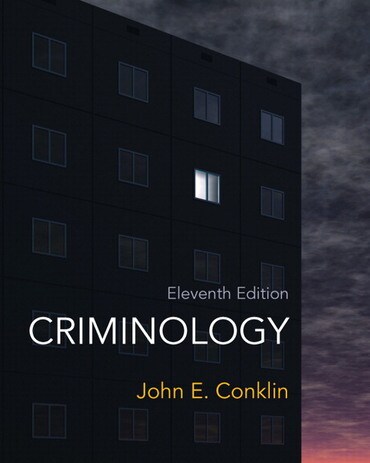
Criminology, 11th edition
Title overview
For courses in Criminology, Introduction to Criminology, Crime and Delinquency, and Sociology of Crime.
The eleventh edition of Criminology is a lively introduction to the study of crime. As opposed to the “crime-of-the-week” approach common to many other texts, Conklin introduces students to critical issues in the field, such as the way people learn to commit crime, the development of criminal careers, and the organization of criminal behavior. The text is illustrated with copious boxed selections, easy-to-interpret tables and graphs, and dozens of compelling boxed features. While thoroughly researched and authoritative, the text is accessible to students and well-suited for one-semester courses.
Hallmark Features
Provides tools to analyze all forms of criminal behavior—using a conceptual approach that organizes chapters around conceptual topics instead of types of crime.
- Discusses concepts such as social control and neutralization of the law, factors that facilitate crime, criminal careers, and the organization of criminal behavior.
- Helps students see the common social processes among conventional crime, white-collar crime, and organized crime.
Offers the most up-to-date, relevant coverage—by drawing on current research by criminologists.
- Includes the latest developments in the field and focuses on what’s relevant to today’s students.
Promotes understanding through extensive pedagogical features—including learning objectives, detailed chapter summaries, key terms lists with page references, review questions, and material for further study.
- Helps students study by clearly identifying important concepts and providing in-depth review material.
Encourages critical thinking—through engaging feature boxes that highlight interesting examples and issues.
- Boxes include Crime and the Media, Crime on Campus, Cross-Culture Perspectives, and Using Criminology
- Critical thinking questions can be assigned or used to promote in-class discussion.
- Numerous new feature boxes focus on global issues and include thought-provoking questions.
- Students can better understand U.S. crime by comparing it to crime elsewhere in the world.
- Helps to maintain the readers’ attention and makes it easier to recognize important points.
New! Increased attention to immigration and immigrants—an important current issue.
- Students will be better able to understand current media discussions about relationships between crime and immigration.
Updated! Rewritten and updated section on biocriminology—including a new section on behavioral genetics.
- Keeps students informed on this new and growing subfield of criminology.
Table of contents
Chapter 1 The Study of Crime
Chapter 2 Measuring Crime
Chapter 3 Crime and Its Costs
Chapter 4 Dimensions of Crime
Chapter 5 Biological and Psychological Explanations of Crime
Chapter 6 Social, Cultural, and Economic Sources of Crime
Chapter 7 Social Control and Commitment to the Law
Chapter 8 Learning to Commit Crime
Chapter 9 Opportunities and Facilitating Factors
Chapter 10 Criminal Careers
Chapter 11 The Organization of Criminal Behavior
Chapter 12 Community Reactions to Crime
Chapter 13 The Criminal Justice System
Chapter 14 Deterrence, Incapacitation, Retribution, and Rehabilitation
Chapter 15 Reducing Crime